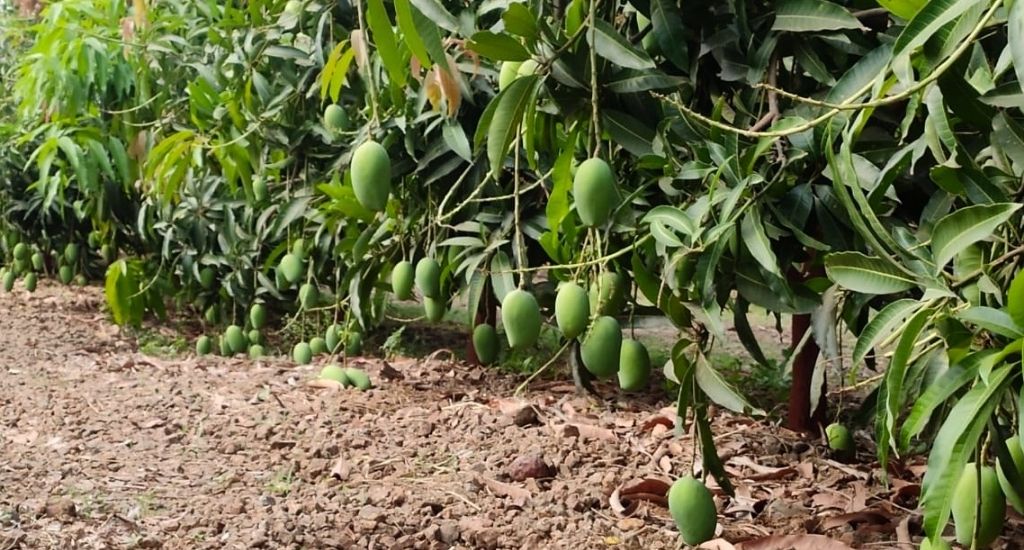For fruit lovers in India, April to June are great months. It is the mango season, a time to gorge on the fruit lovingly called the “king”, although “aam” (the Hindi term for mango) also means “common”. Many Indians eat mangoes for breakfast, lunch and dinner during its short season — simply sliced or sucking straight off the pit.
But Pratap Zende, 37, is eagerly waiting for 2025 to arrive to take a bite of the creamy orange flesh of the first harvest from his four-acre farm at Kavalapur, 15km from Pune in Maharashtra.
Zende isn’t your typical farmer. He was a globetrotting human resource professional with a master’s degree from Rennes School of Business in France until he took a sabbatical and opened a farmstead that contains an orchard, a house to live in, a shed for goats and a pond.
“I invested around Rs 1 crore, which included Rs 200 for each of the 1,000 Kesar mango saplings,” he said. “I hope to start an agri startup soon.”
For fruit lovers in India, April to June are great months. It is the mango season, a time to gorge on the fruit lovingly called the “king”, although “aam” (the Hindi term for mango) also means “common”. Many Indians eat mangoes for breakfast, lunch and dinner during its short season — simply sliced or sucking straight off the pit.
But Pratap Zende, 37, is eagerly waiting for 2025 to arrive to take a bite of the creamy orange flesh of the first harvest from his four-acre farm at Kavalapur, 15km from Pune in Maharashtra.

“I invested around Rs 1 crore, which included Rs 200 for each of the 1,000 Kesar mango saplings,” he said. “I hope to start an agri startup soon.”
That hope springs from a technique known as “ultra high-density plantation” (UHDP), which, as the name suggests, allows farmers to grow more on smaller parcels.
Towards more mangoes
UHDP has been around for some decades. Most apple orchards in Europe, America, Australia and New Zealand follow this technique of planting fruit trees at a closer spacing than recommended in order to obtain maximum yield per acreage without sacrificing quality.
It was successfully applied in India during the 1970s to grow apples, plums, peaches, pineapples, bananas, papayas and citrus fruits. But using it for mango has proven to be a clincher lately.
India is the world’s biggest producer of mangoes, accounting for roughly 40 percent of the global production. The yield can be better with advanced orchard management.
For higher yield, farmers are now practising UHDP mango farming, wherein 100 saplings are planted in a single acre as opposed to 40 in traditional cultivation. While traditional orchards with little to no maintenance can get around 2-3 tonnes of fruits an acre, high density farming can give 9-10 tonnes an acre.

UHDP warrants post-harvest pruning to stop canopy overgrowth to let in sunlight and ensure proper ventilation. Thinning shoots is essential after the pruning to avoid overcrowding. Besides, two doses of fertigation, an annual dose of growth retardant, drip irrigation, and pest and disease control are vital.
In the thick of things
Horticulturist Dr Bhagwanrao Kapse has been encouraging farmers in Maharashtra to adopt UHDP. In 2006, he planted 500 mango plants on 3.5 acres in Osamanabad’s Ruidhar village as a pilot project.
He advocates a total of 666 plants an acre, keeping a distance of 1.5 metres between plants on rows separated by four metres.
“From the third year, an acre can yield three tonnes,” he said.
Kapse has been mentoring scores of farmers.
“There are now close to 20,000 hectares in Maharashtra devoted to this type of plantation,” he said.
Sunil Malgave, 42, of Bhosegaon village in Sangli district is among those reaping the fruits of labour. He planted 150 plants in 2015 on two acres and followed it up with 800 plants on another two acres three years later, including the Kesari, Alphonso, Dasheri and Payeri mango varieties.

“I harvested a tonne, despite the hailstorm in May 2021. I got three tonnes in 2022 and hope to get five this year,” Malgave said.
But no one has been able to touch Parmanand Gavane’s feat. The 64-year-old farmer of Belanki village in Sangli has 1,800 plants on his two-acre orchard, which has now become a tourist attraction.
A stream of visitors file in and out of his farm every day.
“My orchard’s first harvest yielded four tonnes in 2014. Last year, it was 15 tonnes,” said Gavane, who grows mostly the Kesar variety.
But the 500 Rumani plants are the cynosure of his eyes. The Rumani season is from November to March, making it all the more alluring.
High-density farming hasn’t however found favour in the Konkan region — the land of the famed Alphonso, also known as “Hapus”, pronounced with a silent “h”.
“Only a handful of farmers have taken up this method. They either have 200 plants an acre or 400 plants,” said agronomist Dr AS Salvi.
The lead image at the top shows rows of mango trees (Photo by Hiren Kumar Bose)
Hiren Kumar Bose is a journalist based in Thane, Maharashtra. He doubles as a weekend farmer.








